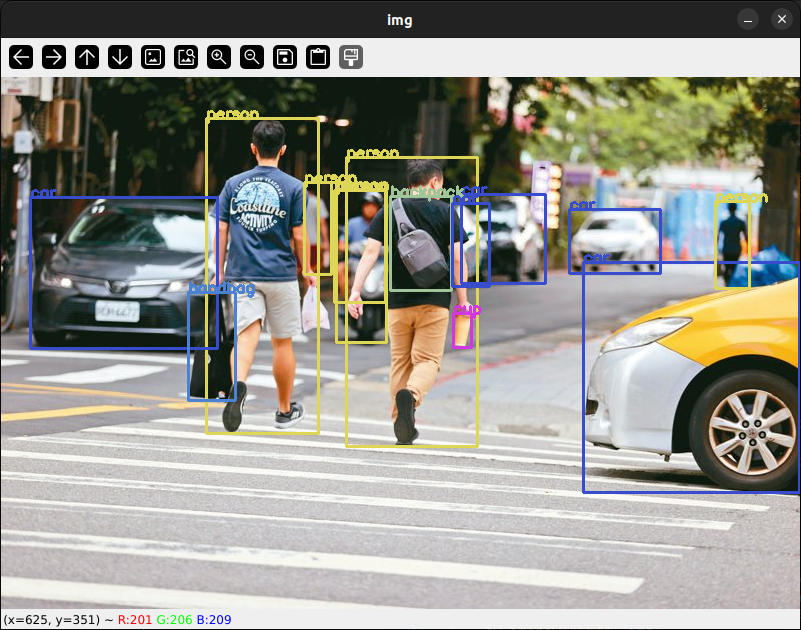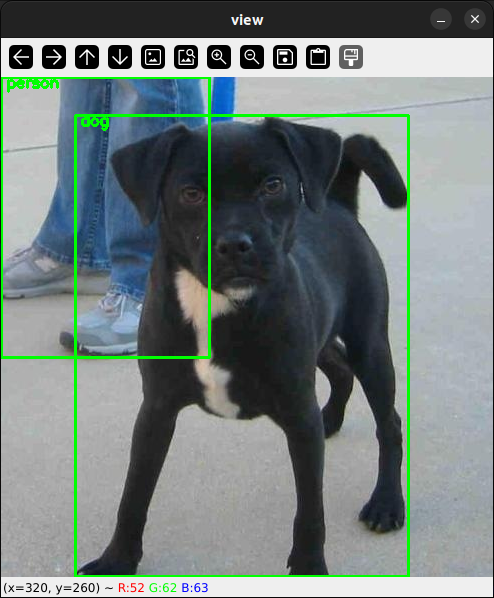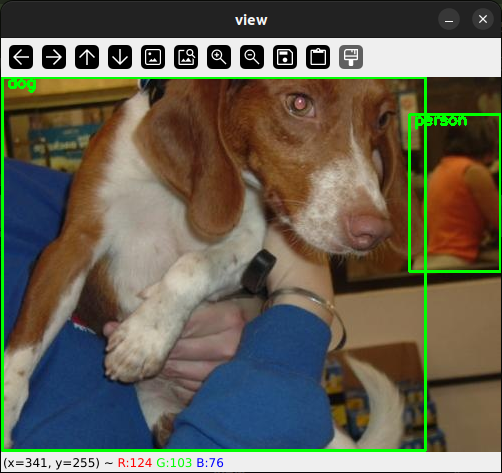项目地址
https://github.com/ultralytics/ultralytics
极简运行效果
获取模型bbox的极简demo
有时候是想要获取yolo检测的bbox框。
python
import random
import cv2 as cv
from ultralytics import YOLO
# model = YOLO("yolov8m.yaml")
# model = YOLO("yolov8m.pt")
model = YOLO("yolov8x.pt")
coco_label = ["person", "bicycle", "car", "motorcycle", "airplane",
"bus", "train", "truck", "boat", "traffic light", "fire hydrant",
"stop sign", "parking meter", "bench", "bird", "cat", "dog", "horse",
"sheep", "cow", "elephant", "bear", "zebra", "giraffe", "backpack",
"umbrella", "handbag", "tie", "suitcase", "frisbee", "skis", "snowboard",
"sports ball", "kite", "baseball bat", "baseball glove", "skateboard",
"surfboard", "tennis racket", "bottle", "wine glass", "cup", "fork",
"knife", "spoon", "bowl", "banana", "apple", "sandwich", "orange",
"broccoli", "carrot", "hot dog", "pizza", "donut", "cake", "chair",
"couch", "potted plant", "bed", "dining table", "toilet", "tv",
"laptop", "mouse", "remote", "keyboard", "cell phone", "microwave",
"oven", "toaster", "sink", "refrigerator", "book", "clock", "vase",
"scissors", "teddy bear", "hair drier", "toothbrush"]
def generate_colors(num_colors):
colors = []
for _ in range(num_colors):
r = random.randint(0, 255)
g = random.randint(0, 255)
b = random.randint(0, 255)
colors.append((r, g, b))
return colors
coco_colors = generate_colors(len(coco_label))
results = model("/media/xp/data/image/sample/person2.jpg")
for r in results:
# print(r.boxes)
img = cv.imread(r.path)
for box in r.boxes:
x1, y1, x2, y2, score, class_id = box.data[0]
x1, y1, x2, y2 = int(x1), int(y1), int(x2), int(y2)
cv.rectangle(img, (x1, y1), (x2, y2), coco_colors[int(class_id)], 2)
cv.putText(img, coco_label[int(class_id)], (x1, y1), cv.FONT_HERSHEY_SIMPLEX, 0.5, coco_colors[int(class_id)], 2)
cv.imshow("img", img)
key = cv.waitKey(0)
if key == 27:
break
用yolov8半自动标注
- auto_label.py
python
import cv2 as cv
from ultralytics import YOLO
import os
import random
coco_label = ["person", "bicycle", "car", "motorcycle", "airplane",
"bus", "train", "truck", "boat", "traffic light", "fire hydrant",
"stop sign", "parking meter", "bench", "bird", "cat", "dog", "horse",
"sheep", "cow", "elephant", "bear", "zebra", "giraffe", "backpack",
"umbrella", "handbag", "tie", "suitcase", "frisbee", "skis", "snowboard",
"sports ball", "kite", "baseball bat", "baseball glove", "skateboard",
"surfboard", "tennis racket", "bottle", "wine glass", "cup", "fork",
"knife", "spoon", "bowl", "banana", "apple", "sandwich", "orange",
"broccoli", "carrot", "hot dog", "pizza", "donut", "cake", "chair",
"couch", "potted plant", "bed", "dining table", "toilet", "tv",
"laptop", "mouse", "remote", "keyboard", "cell phone", "microwave",
"oven", "toaster", "sink", "refrigerator", "book", "clock", "vase",
"scissors", "teddy bear", "hair drier", "toothbrush"]
def generate_colors(num_colors):
colors = []
for _ in range(num_colors):
r = random.randint(0, 255)
g = random.randint(0, 255)
b = random.randint(0, 255)
colors.append((r, g, b))
return colors
coco_colors = generate_colors(len(coco_label))
def get_all_image_files(path, image_path_list,recursive=False):
'''
Get all image files in the path.
Args:
path: the path to search.
image_path_list: the list to store the image path.
recursive: whether to search the path recursively.
'''
if not os.path.exists(path):
print("The path does not exist.")
return
for root, dirs, files in os.walk(path):
for file in files:
if file.endswith('.jpg') or file.endswith('.png') or file.endswith('.jpeg'):
image_path_list.append(os.path.join(root, file))
if not recursive:
break
def predict_image(model, image_path, score_threshold=0.5):
'''
Predict the image.
Args:
model: the model to predict the image.
image_path: the path of the image.
score_threshold: the threshold of the score.
Returns:
bbox: the bounding box of the image. The format is [x1, y1, x2, y2, class_name]
'''
bbox = []
results = model(image_path)
for r in results:
img = cv.imread(r.path)
for box in r.boxes:
x1, y1, x2, y2, score, class_id = box.data[0]
if score < score_threshold:
continue
# x1, y1, x2, y2 = int(x1), int(y1), int(x2), int(y2)
bbox.append([x1, y1, x2, y2, coco_label[int(class_id)]])
return bbox
def autolabel(src_image_root, save_root, calss_names=[], score_threshold=0.5):
'''
Autolabel the image.
Args:
src_image_root: the root of the source image.
save_root: the root to save the image.
calss_names: the class names to label.
score_threshold: the threshold of the score.
'''
model = YOLO("yolov8x.pt")
image_save_root = os.path.join(save_root, "images")
label_save_root = os.path.join(save_root, "labels")
os.makedirs(image_save_root, exist_ok=True)
os.makedirs(label_save_root, exist_ok=True)
image_path_list = []
get_all_image_files(src_image_root, image_path_list, recursive=True)
current_num = 0
total_num = len(image_path_list)
for image_path in image_path_list:
bbox = predict_image(model, image_path, score_threshold=score_threshold)
img = cv.imread(image_path)
if img is None:
print("The image is None.")
continue
file_name = f"{str(current_num).zfill(6)}"
image_save_path = os.path.join(image_save_root, file_name + ".jpg")
label_save_path = os.path.join(label_save_root, file_name + ".txt")
cv.imwrite(image_save_path, img)
with open(label_save_path, "w") as f:
for box in bbox:
x1, y1, x2, y2, class_name = box
if class_name not in calss_names:
continue
cx = (x1 + x2) // 2
cy = (y1 + y2) // 2
w = x2 - x1
h = y2 - y1
# normalize the value
cx /= img.shape[1]
cy /= img.shape[0]
w /= img.shape[1]
h /= img.shape[0]
f.write(f"{class_name} {cx} {cy} {w} {h}\n")
current_num += 1
print(f"{current_num}/{total_num}")
print(f"image_save_path: {image_save_path} \n label_save_path: {label_save_path}")
def demo_of_autolabel():
src_image_root = "/media/xp/data/image/sentinel/raw/test_data/del/"
save_root = "/media/xp/data/image/sentinel/raw/test_data/del/dataset"
calss_names = ["person", "dog", "cat"]
score_threshold = 0.5
autolabel(src_image_root, save_root, calss_names, score_threshold)
def simple_demo():
model = YOLO("yolov8x.pt")
results = model("/media/xp/data/image/sample/person2.jpg")
for r in results:
# print(r.boxes)
img = cv.imread(r.path)
for box in r.boxes:
x1, y1, x2, y2, score, class_id = box.data[0]
x1, y1, x2, y2 = int(x1), int(y1), int(x2), int(y2)
cv.rectangle(img, (x1, y1), (x2, y2), coco_colors[int(class_id)], 2)
cv.putText(img, coco_label[int(class_id)], (x1 , y1 ), cv.FONT_HERSHEY_SIMPLEX, 0.5, coco_colors[int(class_id)], 2)
cv.imshow("img", img)
key = cv.waitKey(0)
if key == 27:
break
if __name__ == "__main__":
# simple_demo()
demo_of_autolabel()
- visualize_yolo_dataset.py
python
import os
import cv2 as cv
import numpy as np
import json
def get_all_image_files(path, image_path_list,recursive=False):
'''
Get all image files in the path.
Args:
path: the path to search.
image_path_list: the list to store the image path.
recursive: whether to search the path recursively.
'''
if not os.path.exists(path):
print("The path does not exist.")
return
for root, dirs, files in os.walk(path):
for file in files:
if file.endswith('.jpg') or file.endswith('.png') or file.endswith('.jpeg'):
image_path_list.append(os.path.join(root, file))
if not recursive:
break
def get_all_labels_from_image_lists(image_path_list, label_path_list):
for image_path in image_path_list:
image_folder = os.path.dirname(image_path) # xx/yy/images
label_folder = os.path.join(os.path.dirname(image_folder), "labels") # xx/yy/labels
image_name = os.path.basename(image_path)
label_name = os.path.splitext(image_name)[0] + ".txt"
label_path = os.path.join(label_folder, label_name)
if not os.path.exists(label_path):
print(f"The label path does not exist, path:{label_path}.")
continue
label_path_list.append(label_path)
def get_bbox_from_yolo_txt(yolo_txt_path, image_path=None):
'''
Parse the yolo txt file.
Args:
yolo_txt_path: the path of the yolo txt file.
Returns:
bbox_list: the list of bbox. bbox is a list of [x1, y1, x2, y2, label].
'''
if not os.path.exists(yolo_txt_path):
print(f"The yolo txt path does not exist, path:{yolo_txt_path}.")
return
if image_path is not None and not os.path.exists(image_path):
print(f"The image path does not exist, path:{image_path}.")
return
if image_path is not None:
image = cv.imread(image_path)
image_h, image_w, _ = image.shape
bbox_list = []
with open(yolo_txt_path, 'r') as f:
lines = f.readlines()
for line in lines:
line = line.strip()
label , x1, y1, w, h = line.split(" ")
x1 = float(x1)
y1 = float(y1)
w = float(w)
h = float(h)
x1 = x1 - w / 2
y1 = y1 - h / 2
x2 = x1 + w
y2 = y1 + h
x1 = x1 * image_w
y1 = y1 * image_h
x2 = x2 * image_w
y2 = y2 * image_h
bbox_list.append([x1, y1, x2, y2, label])
return bbox_list
def draw_bbox(image, bbox_list, color=(0, 255, 0)):
'''
Draw the bbox on the image.
Args:
image_path: the path of the image.
bbox_list: the list of bbox. bbox is a list of [x1, y1, x2, y2, label].
save_path: the path to save the image.
'''
for bbox in bbox_list:
x1, y1, x2, y2, label = bbox
x1 = int(x1)
y1 = int(y1)
x2 = int(x2)
y2 = int(y2)
cv.rectangle(image, (x1, y1), (x2, y2), color, 2)
cv.putText(image, label, (x1 + 5, y1 + 10), cv.FONT_HERSHEY_SIMPLEX, 0.5, color, 2)
return image
def visualize_dataset(dataset_path):
image_path_list = []
label_path_list = []
get_all_image_files(dataset_path, image_path_list, recursive=True)
get_all_labels_from_image_lists(image_path_list, label_path_list)
assert len(image_path_list) == len(label_path_list) , f"The number of image and label is not equal. image:{len(image_path_list)}, label:{len(label_path_list)}."
for i in range(len(image_path_list)):
image_path = image_path_list[i]
label_path = label_path_list[i]
bbox_list = get_bbox_from_yolo_txt(label_path, image_path)
print(f"image_path:{image_path}, label_path:{label_path}, bbox_list:{bbox_list}")
image = cv.imread(image_path)
view = draw_bbox(image, bbox_list)
cv.imshow("view", view)
key = cv.waitKey(0)
if key == 27:
break
def demo_of_visualize_dataset():
dataset_dir = "/media/xp/data/image/sentinel/raw/test_data/del/dataset"
visualize_dataset(dataset_dir)
if __name__ == "__main__":
demo_of_visualize_dataset()
使用流程,先运行auto_label.py,把所有图片预测保存到一个路径下面,目前保存为jpg图片。然后用visualize_yolo_dataset.py检查自动标注的结果。从结果看的话基本bbox还是比较准的,但是会有漏,那就需要自己手动调整了。另外这里的txt里面的label用字符串,而不是0,1,2,3...,后面写个脚本转换为自己数据集的class_id就ok了。
下面是自动标注后的可视化结果。

